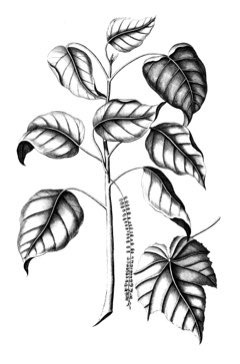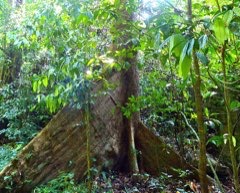 |
|
http://www.edibleplants.org |
 |
| Bernard DUPONT wikimedia.org |
Translate this page:
Summary
Octomeles sumatrana or commonly known as Ilimo Tree is a dioecious and large tree growing about 75 m tall and can be found in Brunei, Philippines, Malaysia, Papua New Guinea, Indonesia, and the Solomon Islands. It is fast-growing and evergreen, with a semi-globose crown and a straight, buttressed bole which can be about 400 cm in diameter. The extract of leaves are used as relief from stomach pains. Young leaves can be cooked and eaten as vegetables. Ilimo tree has an extensive root system making it ideal for preventing soil erosion in sloping areas. It is also a pioneer species and resistant to fire damage. The bark yields dye. The wood is light, fairly soft, and only used for match boxes, concrete moulds, pallets, etc. It is also used for pulp.
Physical Characteristics

 Octomeles sumatrana is an evergreen Tree growing to 50 m (164ft) by 30 m (98ft) at a fast rate.
Octomeles sumatrana is an evergreen Tree growing to 50 m (164ft) by 30 m (98ft) at a fast rate.
See above for USDA hardiness. It is hardy to UK zone 10. The flowers are pollinated by Bees.
Suitable for: medium (loamy) and heavy (clay) soils and prefers well-drained soil. Suitable pH: mildly acid and neutral soils and can grow in very acid soils.
It cannot grow in the shade. It prefers moist soil.
UK Hardiness Map
US Hardiness Map
Synonyms
This name is unresolved.
Plant Habitats
Edible Uses
Edible Parts: Leaves
Edible Uses:
Young leaves - cooked and eaten as a vegetable[451 ].
References More on Edible Uses
Medicinal Uses
Plants For A Future can not take any responsibility for any adverse effects from the use of plants. Always seek advice from a professional before using a plant medicinally.
A leaf extract is used to cure stomach-ache[325 ].
References More on Medicinal Uses
The Bookshop: Edible Plant Books
Our Latest books on Perennial Plants For Food Forests and Permaculture Gardens in paperback or digital formats.

Edible Tropical Plants
Food Forest Plants for Hotter Conditions: 250+ Plants For Tropical Food Forests & Permaculture Gardens.
More

Edible Temperate Plants
Plants for Your Food Forest: 500 Plants for Temperate Food Forests & Permaculture Gardens.
More

More Books
PFAF have eight books available in paperback and digital formats. Browse the shop for more information.
Shop Now
Other Uses
Dye Pioneer Soil stabilization Wood
Agroforestry Uses: The trees extensive root system binds the soil, making it an ideal plant for stabilizing river banks[451 ]. The tree is actually a pioneer species in the rainforest, rapidly invading new banks of alluvial soil built up by the rivers, but unable to regenerate once other trees close the canopy below them[451 ]. Other Uses A dye is obtained from the bark[418 ]. The heartwood is absent. The wood is light, relatively soft, coarse-textured, brittle and with poor resistance to decomposition. It is only suitable for use under cover where a weak, perishable timber will suffice, being employed to make match boxes, concrete moulds, pallets etc, and for pulp[325, 451]. The colossal stems are, however, suitable for making large canoes[451 ].
Special Uses
Food Forest
References More on Other Uses
Cultivation details
A tree of the moist, lowland tropics where it is generally found at elevations below 1,000 metres[451 ]. It grows best in areas where annual daytime temperatures are within the range 29 - 34c, but can tolerate 20 - 38c[418 ]. It prefers a mean annual rainfall in the range 3,000 - 4,000mm, but tolerates 2,000 - 5,000mm[418 ]. Requires a sunny position[325 ]. Succeeds in alluvial soils, clays and sandy loams[325 ]. Prefers a pH in the range 4.5 - 5.5, tolerating 4 - 6.5[418 ]. Trees can be exceptionally fast growing, with one report of a 4-year old specimen having attained a height of 25 metres and a bole diameter of 47cm[451 ]. Annual wood production potential is 25 - 40 cubic metres per hectare[418 ]. Trees are resistant to fire damage[451 ]. A dioecious species, both male and female forms need to be grown if seed is required[325 ].
References Carbon Farming Information and Carbon Sequestration Information
Temperature Converter
Type a value in the Celsius field to convert the value to Fahrenheit:
Fahrenheit:
The PFAF Bookshop
Plants For A Future have a number of books available in paperback and digital form. Book titles include Edible Plants, Edible Perennials, Edible Trees,Edible Shrubs, Woodland Gardening, and Temperate Food Forest Plants. Our new book is Food Forest Plants For Hotter Conditions (Tropical and Sub-Tropical).
Shop Now
Plant Propagation
Seed - it has a fairly short viability and should be sown before it is 12 months old[451 ]. It does not have a dormancy, and pre-treatment is not necessary. It probably germinates better in a sunny position. Seeds are sown in a nursery seedbed and only just covered, Germination will usually take place within 7 days. Prick out the seedlings into individual pots when they have 4 leaves and place in semi-shade for one week before returning them to a sunny position[325 ]. Plant out when 30cm tall[325 ].
Other Names
If available other names are mentioned here
Ilimo Tree
Native Range
Coming Soon
Weed Potential
Right plant wrong place. We are currently updating this section.
Please note that a plant may be invasive in one area but may not in your area so it's worth checking.
Conservation Status
IUCN Red List of Threatened Plants Status : Status: Lower Risk/least concern

Growth: S = slow M = medium F = fast. Soil: L = light (sandy) M = medium H = heavy (clay). pH: A = acid N = neutral B = basic (alkaline). Shade: F = full shade S = semi-shade N = no shade. Moisture: D = dry M = Moist We = wet Wa = water.
Now available:
Food Forest Plants for Mediterranean Conditions
350+ Perennial Plants For Mediterranean and Drier Food Forests and Permaculture Gardens.
[Paperback and eBook]
This is the third in Plants For A Future's series of plant guides for food forests tailored to
specific climate zones. Following volumes on temperate and tropical ecosystems, this book focuses
on species suited to Mediterranean conditions—regions with hot, dry summers and cool, wet winters,
often facing the added challenge of climate change.
Read More
Expert comment
Author
Miq.
Botanical References
Links / References
For a list of references used on this page please go here
A special thanks to Ken Fern for some of the information used on this page.
Readers comment
| Add a comment |
|
If you have important information about this plant that may help other users please add a comment or link below. Only comments or links that are felt to be directly relevant to a plant will be included. If you think a comment/link or information contained on this page is inaccurate or misleading we would welcome your feedback at [email protected]. If you have questions about a plant please use the Forum on this website as we do not have the resources to answer questions ourselves.
* Please note: the comments by website users are not necessarily those held by PFAF and may give misleading or inaccurate information.
To leave a comment please Register or login here All comments need to be approved so will not appear immediately.
|
Subject : Octomeles sumatrana
|
|
|
|